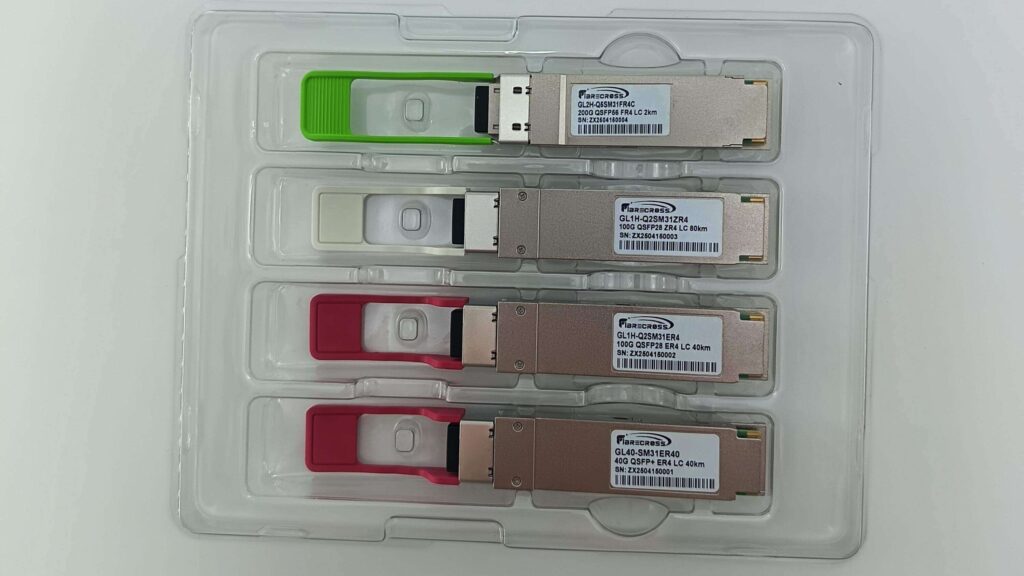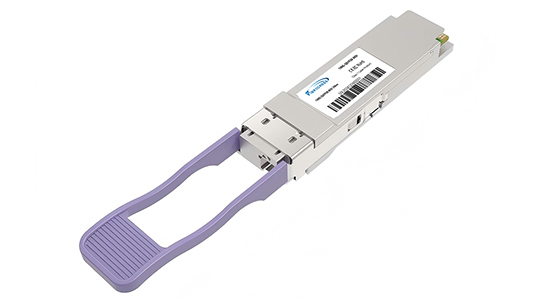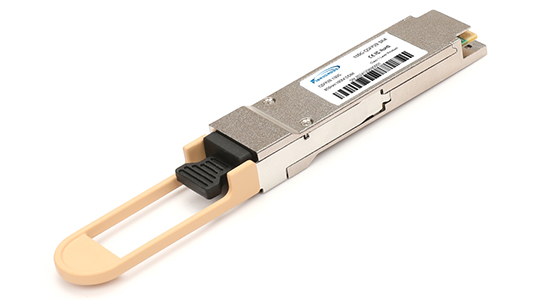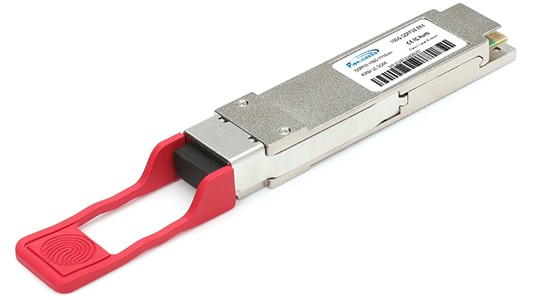A Comprehensive Guide to 100G QSFP28 Optical Transceiver(2025)
Modern data centers rely on high-speed optical links, and 100G optical transceiver modules (especially the QSFP28 form factor) are now foundational for this connectivity. 100G transceivers convert electrical signals to laser light over fiber, enabling top-of-rack switches to connect to aggregation and core layers at 100 Gbps. Compared to legacy 100G form factors (CFP/CFP2/CFP4), QSFP28 modules offer a smaller footprint, lower power consumption, and higher port density. In practice, 100G QSFP28 transceivers fill uplink or spine slots to aggregate data or to carry traffic between racks. They are widely used in leaf-spine architectures and also in data center interconnect (DCI) links over metro distances. The growing demand for cloud services, AI, and 5G networks is driving the 100G optical transceiver market, which is expected to grow as a subset of the broader optical transceiver market.
Technology Overview: 100G QSFP28 Transceiver Modules
A 100G optical transceiver module is an optical-electrical interface that supports 100 Gbps Ethernet, InfiniBand EDR, or Fibre Channel. The QSFP28 (Quad Small Form-factor Pluggable 28) module is the dominant 100G form factor. Physically, QSFP28 has the same size as its 40G predecessor (QSFP+), but its electrical interface supports four channels of up to 25–28 Gbps each. Internally, the module contains four transmit/receive lanes that are multiplexed or de-multiplexed in the optical domain. This four-lane architecture allows QSFP28 transceivers to meet 100 GbE (4×25G) and 4×25 Gbps InfiniBand requirements. The QSFP28 form factor is MSA-compliant, meaning multi-source manufacturers produce interoperable modules.
A QSFP28 LR4 is a 10 km single-mode module with 4 WDM wavelengths; a QSFP28 SR4 uses 8 MMF fibers to reach 100 m.) These modules typically include Digital Diagnostics Monitoring (DDM) and hot-pluggable interfaces (e.g. duplex LC for LR4/CWDM4, MPO for SR4/PSM4). Overall, QSFP28 100G modules provide a leap in density and cost-efficiency: they support higher speed in a smaller, lower-power package than older CFP2/CFP4 100G transceivers.
Deployment Scenarios in Data Centers
In a leaf-spine network, 100G QSFP28 modules are commonly used on spine or aggregation switches to carry uplinks and cross-rack traffic. 100G transceivers often bridge the ToR (leaf) layer to the core (spine) layer, with each spine port typically running 100G. When switched throughput exceeds 100G, carriers may break a 100G QSFP28 link into 4×25G downlinks using breakout cables. For very short distances (within the same rack), 100G DAC (direct-attach copper) or AOC (active optical cables) are cost-effective options (up to a few meters). For multi-mode fiber spans of 5–100 m, QSFP28 SR4 modules (with 12-fiber MPO) or QSFP28 AOC can link switches without extra re-cabling. This high-density cabling lets operators support many ports in a compact switch chassis.
Overall, 100G QSFP28 transceivers enable high-density connectivity. By supporting 4×25G per port, they allow switch vendors to pack more bandwidth into the same chassis space. This is vital for modern data centers where port count and port speed both matter. Operators can mix and match 100G modules and 10/25G modules (in SFP28 slots) to build flexible leaf-spine fabrics. The growing ecosystem of 100G products (modules, cables, breakout boxes) means 100G links can be as simple as plugging in a QSFP28 and an MPO/LC cable, just as 10G links were a decade ago.
100G Transceiver Types and Ranges100G
Data centers deploy several types of 100G QSFP28 modules tailored to reach and cable. Key types include:
100GBASE-SR4 – Short-range multimode (typically OM3/OM4). Supports up to ~100 m (70 m on OM3 or 100 m on OM4) using 12-fiber MPO/MTP cable. Ideal for within-rack or adjacent-rack links. (Power consumption is low, but you need multi-mode fiber and MPO connectors.)
100GBASE-LR4 – Long-range single-mode. Supports 10 km over SMF using 4× 25G LAN-WDM wavelengths (around 1310 nm) on duplex LC connectors. Standard for building-to-building or campus links up to 10 km. (Some extended LR4 modules go ~20 km.)
100GBASE-CWDM4 – Coarse WDM. Single-mode, ~2 km reach, duplex LC. Uses 4 CWDM wavelengths (1270/1290/1310/1330 nm) on 1310 nm optics. Lower cost than LR4, since it often omits more complex laser tuning; useful for 2 km-ish SMF links (e.g. across a campus).
100GBASE-PSM4 – Parallel single-mode. Up to 500 m–2 km on SMF, uses 8-fiber MPO cable (4 transmit, 4 receive) at 1310 nm. Lower per-fiber speed (25G each) but high density. (In practice, many data centers use PSM4 up to about 500 m.)
100GBASE-ER4 – Extended reach. Approximately 40 km on SMF, using 4× 25G DWDM channels (tunable or fixed) on LC. Often built as CWDM LAN-WDM lasers at 1310 nm that can be tuned with limited range. Used for long-haul DCI links.
100GBASE-DR4 – Short-range single-lambda. A newer MSA type (support ~500 m on SMF with 4× 25G on 1310 nm, duplex LC). Similar reach to PSM4 but only 2 fibers.
Other variants: FR4 (~2 km SMF with 1310 nm, duplex LC) and ZR4 (up to 80 km coherent over C-band) are used in specialized cases. There are also QSFP28 DR1/FR1 modules (100G over one lambda for 2 km/10 km) mainly in breakout or special applications.
Each type is IEEE- or MSA-standard. When choosing modules, data center operators must ensure connector and fiber type match. For example, SR4 and PSM4 need MPO/MTP trunk cables, while LR4/CWDM4/ER4 use LC duplex. (Notably, QSFP28 SR4 is one of the few that requires MPO/MTP connectors in an LC world.) These options mean a 100G link can be optimized for distance vs. cost. For instance, if a 100G link is <500 m on SMF, PSM4 or even a DAC/AOC might be cheapest. If ~2 km, CWDM4 is usually most cost-effective. Beyond 10 km, operators step up to LR4/ER4 or coherent optics. In summary, data centers run a mix of 100G transceiver types: SR4 for short MMF, CWDM4/PSM4 for campus SMF, LR4 for building-to-building, and ER/ZR for long haul.

100G Optical Transceiver Market Trends
The 100G optical transceiver market sits at the intersection of data center growth and network evolution. Overall, the global optical transceiver market is booming: it was roughly $12.6 billion in 2024 and is projected to exceed $42 billion by 2032, driven by 5G, cloud, AI, and IoT. Data centers are a major segment, accounting for a large share of high-speed optics spending. Specifically for 100G modules, demand remains robust, though growth is now being supplemented by 200G/400G sales. Large hyperscale operators (like Google, Microsoft, Meta) are moving to 400G ports internally, but 100G QSFP28 links are still widely used in new builds and as affordable expansion options.
Looking ahead, growth in the 100G market is tempered by the advent of higher rates. The next wave of data center upgrades centers on 400G and beyond. As operators deploy more 400G switches (using QSFP-DD or OSFP optics), the percentage of new 100G shipments may decline. Nevertheless, many networks are not 100% migrated yet, so 100G QSFP28 modules will remain a staple for several years. The optics market report notes that as data centers increasingly adopt 400G/800G, advanced transceivers will be in demand, but the overall DC transceiver market growth is moderate (expected low single-digit CAGR). In short, 100G transceivers are abundant and relatively affordable today, but operators should plan for a shift to 400G/800G over time.
Buying Tips for 100G Optical Transceivers
When procuring 100G QSFP28 optics, data center operators should consider several practical factors:
Link Distance and Fiber Type: First, confirm the required reach. For <100 m on OM3/OM4 multimode, use SR4 (or DAC/AOC). For 100 m–2 km on single-mode, choose PSM4 or CWDM4 (PSM4 needs 8-fiber trunk; CWDM4 uses 2 fibers). For 2–10 km, LR4 (4-wavelength LC) is standard. Beyond that, ER4/ZR4 or DWDM optics are needed. Match module type to your fiber plant and distance – using the wrong type can waste budget or fail to link.
Compatibility and Certification: Ensure the transceivers are compatible with your switches. Major brands often require “vendor-certified” optics or will lock out unbranded modules. Many third-party 100G QSFP28 modules explicitly list compatibility with Cisco, Arista, Juniper, Mellanox, and others. When buying third-party (white-label) modules, check that they are MSA-compliant and have been tested on your hardware. Look for vendor datasheets or compatibility guides.
Port Breakout and Flexibility: If using 100G breakout (4×25G), make sure the QSFP28 supports it. Most SR4/CWDM4 modules can be used with 4×25G split, but verify your switch line card supports breakout cables or breakout AOCs. Also consider if you need features like digital diagnostics or temperature grade (commercial vs. industrial temperature range).
Vendor and Price: Compare OEM vs third-party costs. Branded transceivers carry a premium. Certified third-party 100G transceivers can save cost, but choose reputable suppliers with warranties. Because 100G QSFP28 has been in volume production for years, prices have fallen – bulk SR4 modules can be on the order of ~$20–50 each, and LR4 around $150–300, depending on brand and quantity. Shop around and negotiate for bulk purchases. Also factor in support and lead times – some custom or newer modules (like tunable ZR) may have longer lead times.
Cabling and Density: Plan your cabling. SR4 and PSM4 use MPO trunks (12-fiber for SR4 or 8-fiber for PSM4), whereas LR4/CWDM4 use duplex LC. Use high-quality fiber (OM4 or SMF-28) to get the maximum reach. For high port counts, consider QSFP28 AOCs or MPO cassettes to simplify cable management. Remember that QSFP28 links carry four lanes; in dense racks this means many fibers or cables in the patch panel – budget for high-density MPO panels if needed.
By carefully assessing the above factors (distance, switch support, fiber, and cost), data center operators can select the right 100G QSFP28 optical transceivers for their needs. The goal is to balance performance, compatibility, and budget while ensuring room for future upgrades.

400G and the Future
While 100G remains common today, the industry is already shifting toward 400G Ethernet (and beyond). Upgrading to 400G transceivers provides fourfold bandwidth on a single interface, simplifying the network. According to industry sources, 400G adoption offers “increased bandwidth and scalability” and “optimal resource utilization,” allowing data centers to consolidate links and prepare for future growth. In practice, many operators choose a gradual migration: leaving leaf switches at 100G (e.g. for server racks) while upgrading spine or core switches to 400G QSFP-DD or OSFP modules. This mixed deployment increases capacity without reworking the entire network at once. Eventually, 800G and 1.6T technologies will emerge for hyperscale needs, but for now 100G QSFP28 transceivers offer a cost-effective, proven solution for workloads that do not yet require 400G.
In summary, 100G QSFP28 optical transceivers are a mature, essential technology in today’s data centers. They provide a range of distances (100 m to 40 km) and enable dense, high-speed fabrics. Data center operators choosing 100G optics should match the transceiver type to their fiber and distance, verify compatibility, and consider cost versus vendor. As the market evolves, 100G modules will coexist with emerging 400G/800G deployments. By understanding current 100G technologies and market trends, operators can make informed decisions and smoothly transition to higher speeds when needed.





